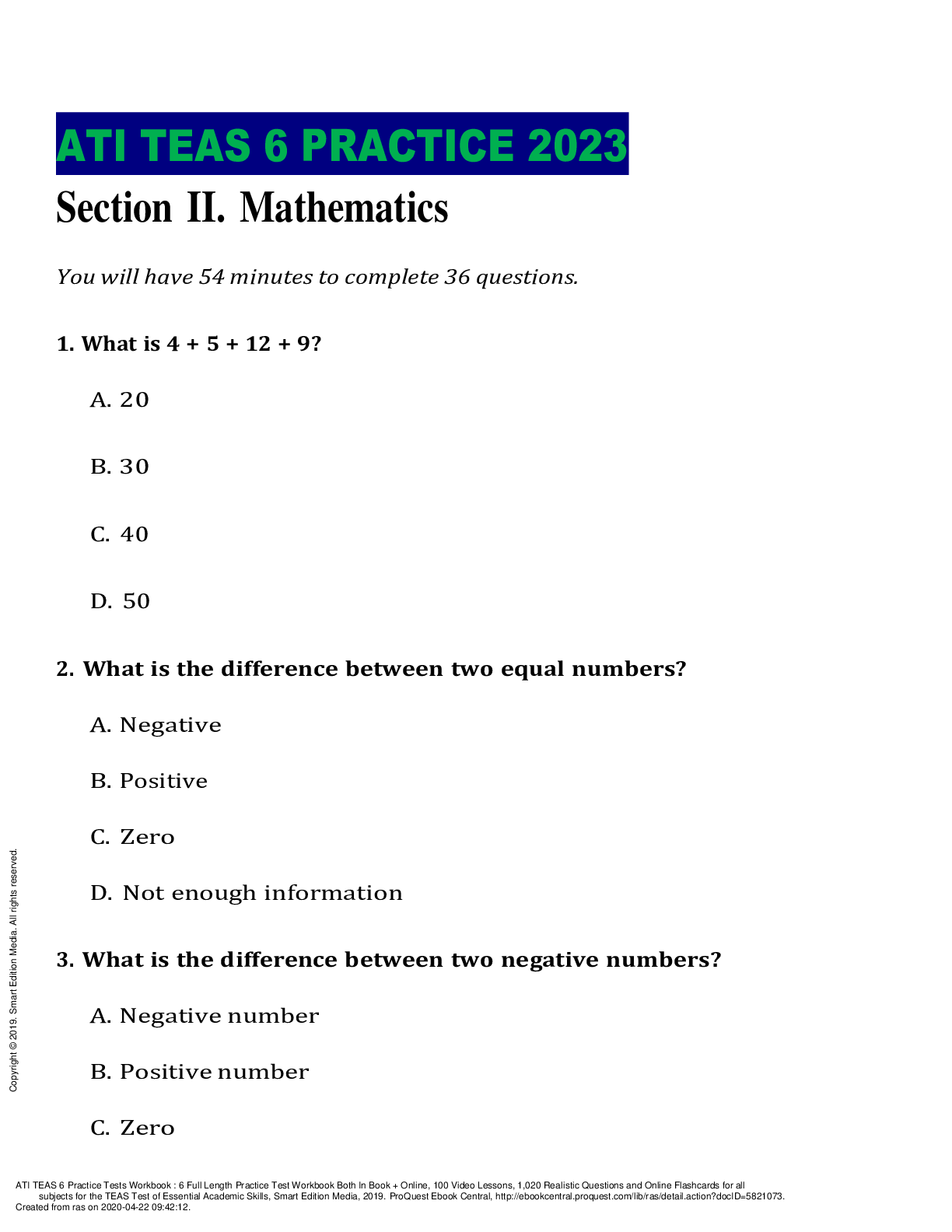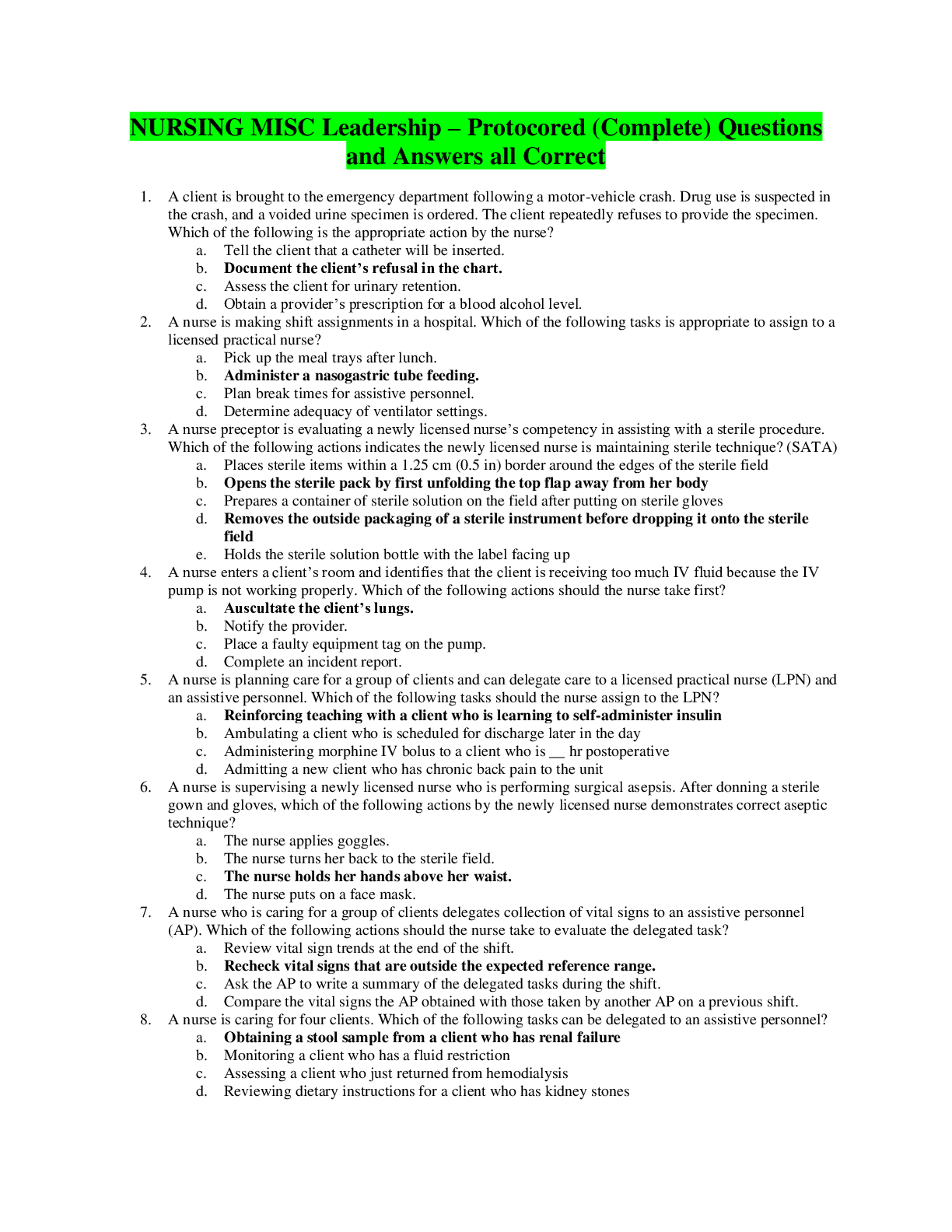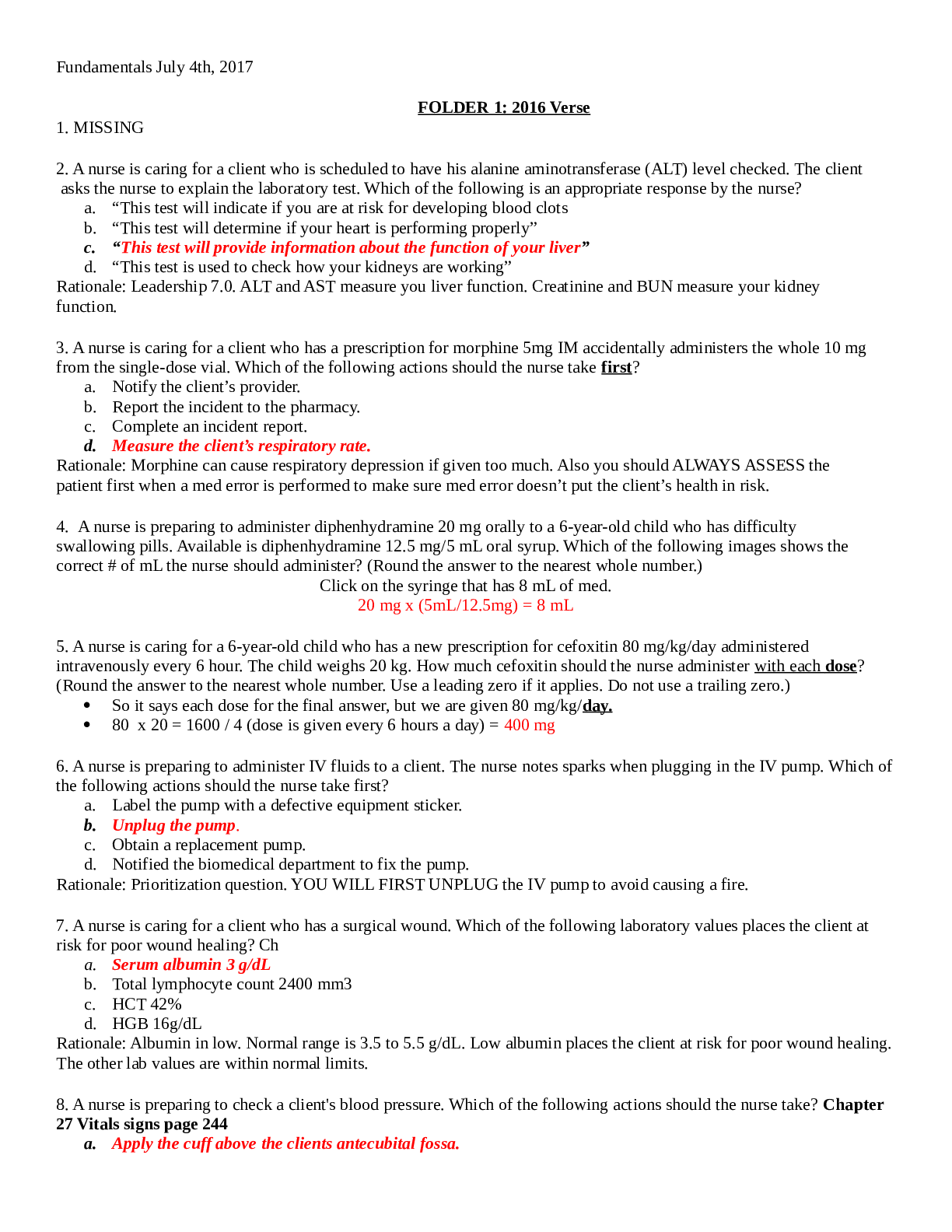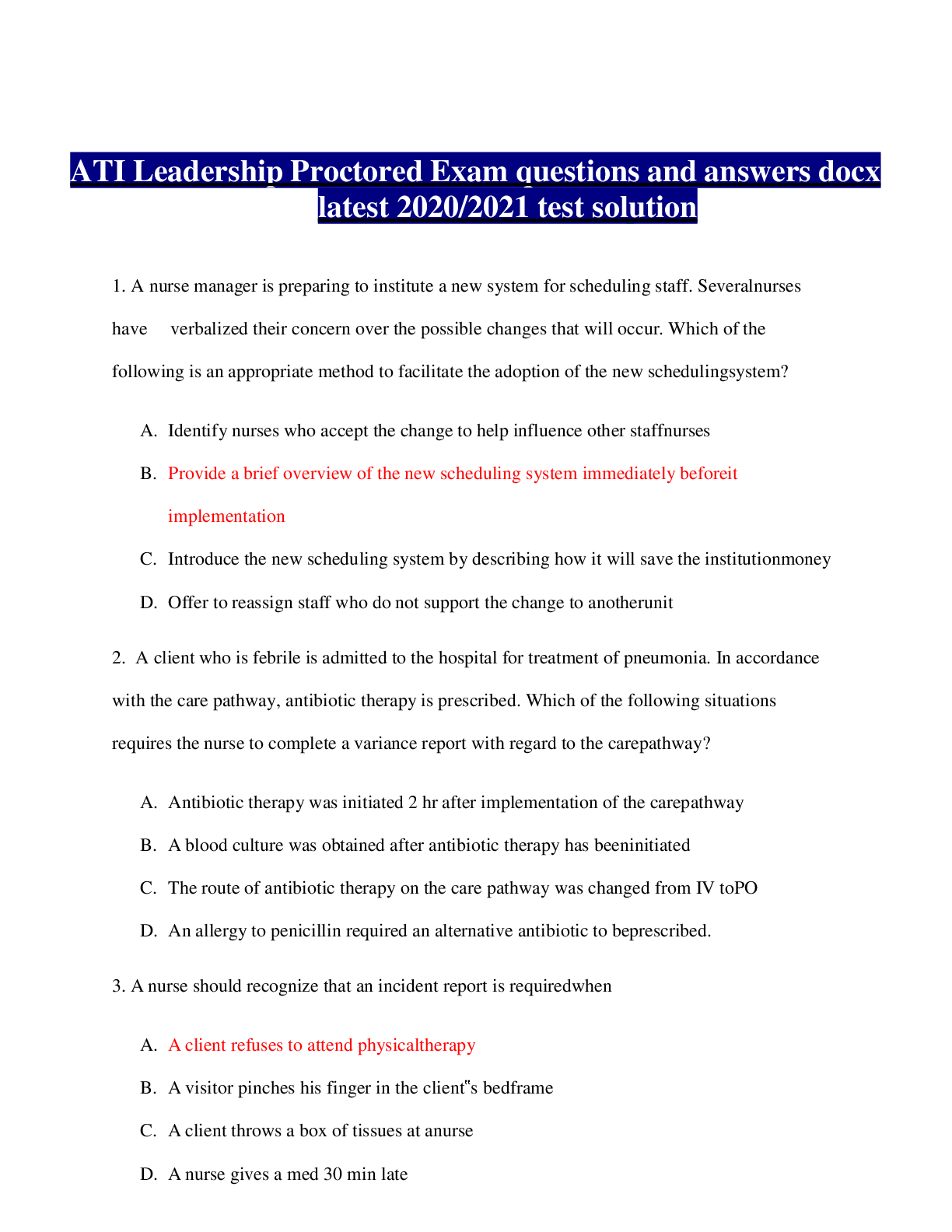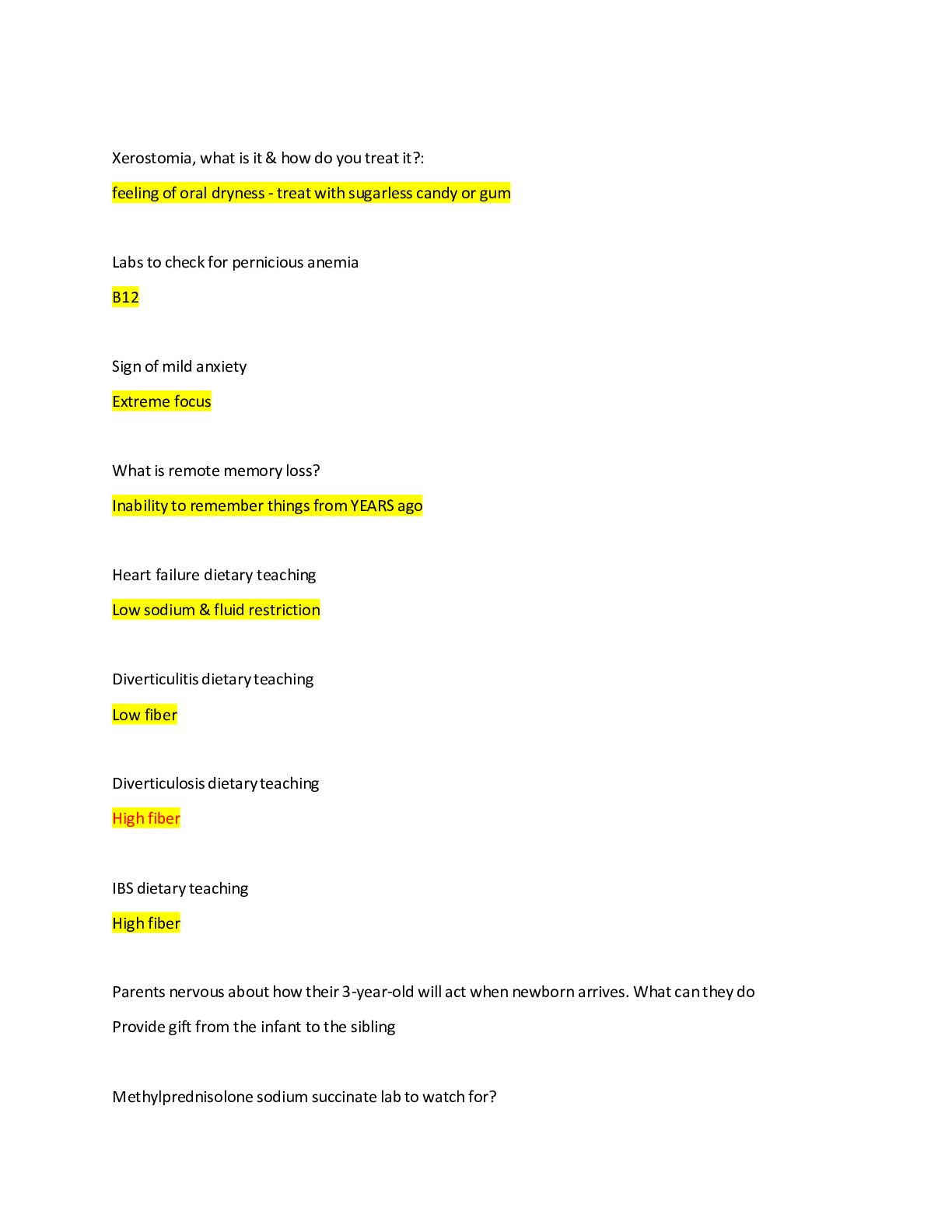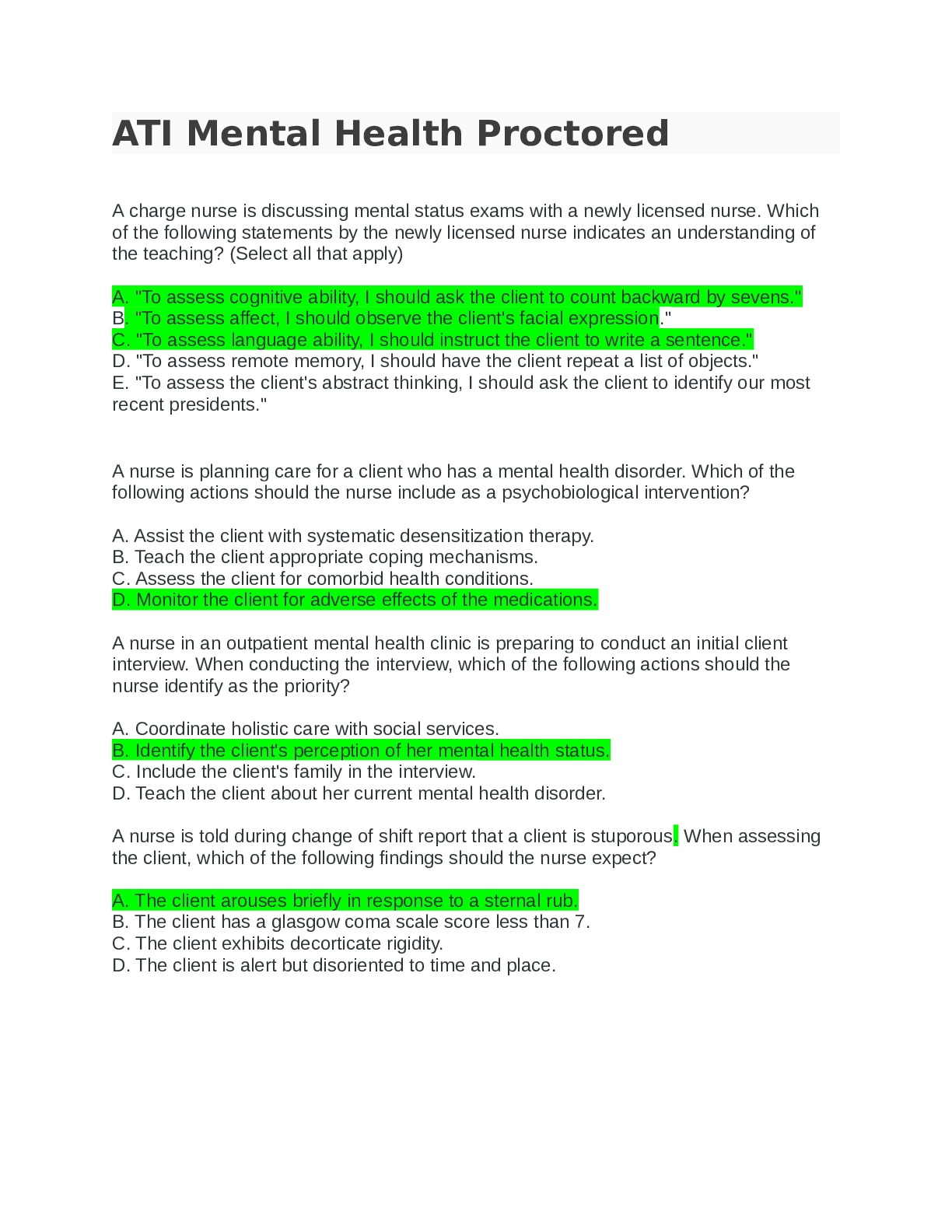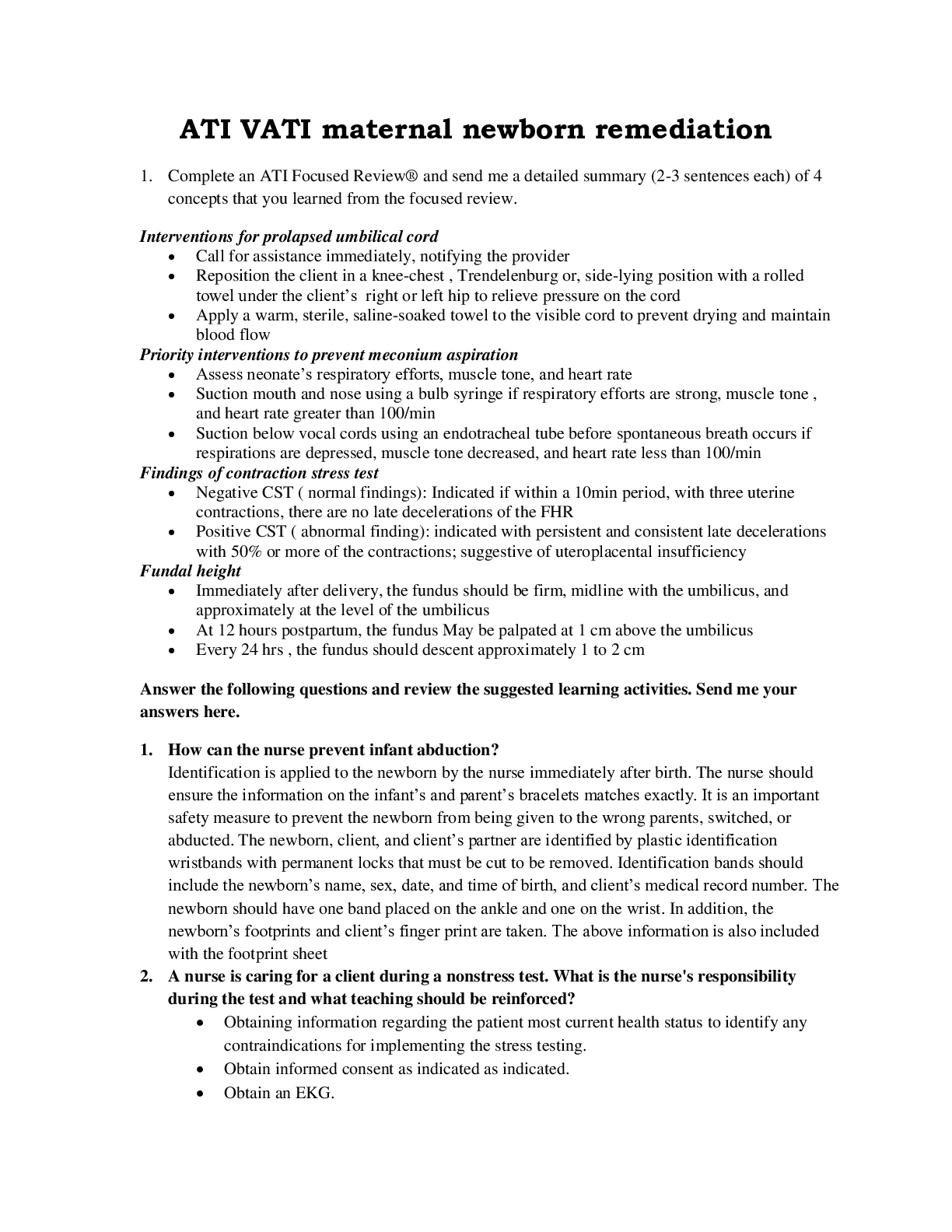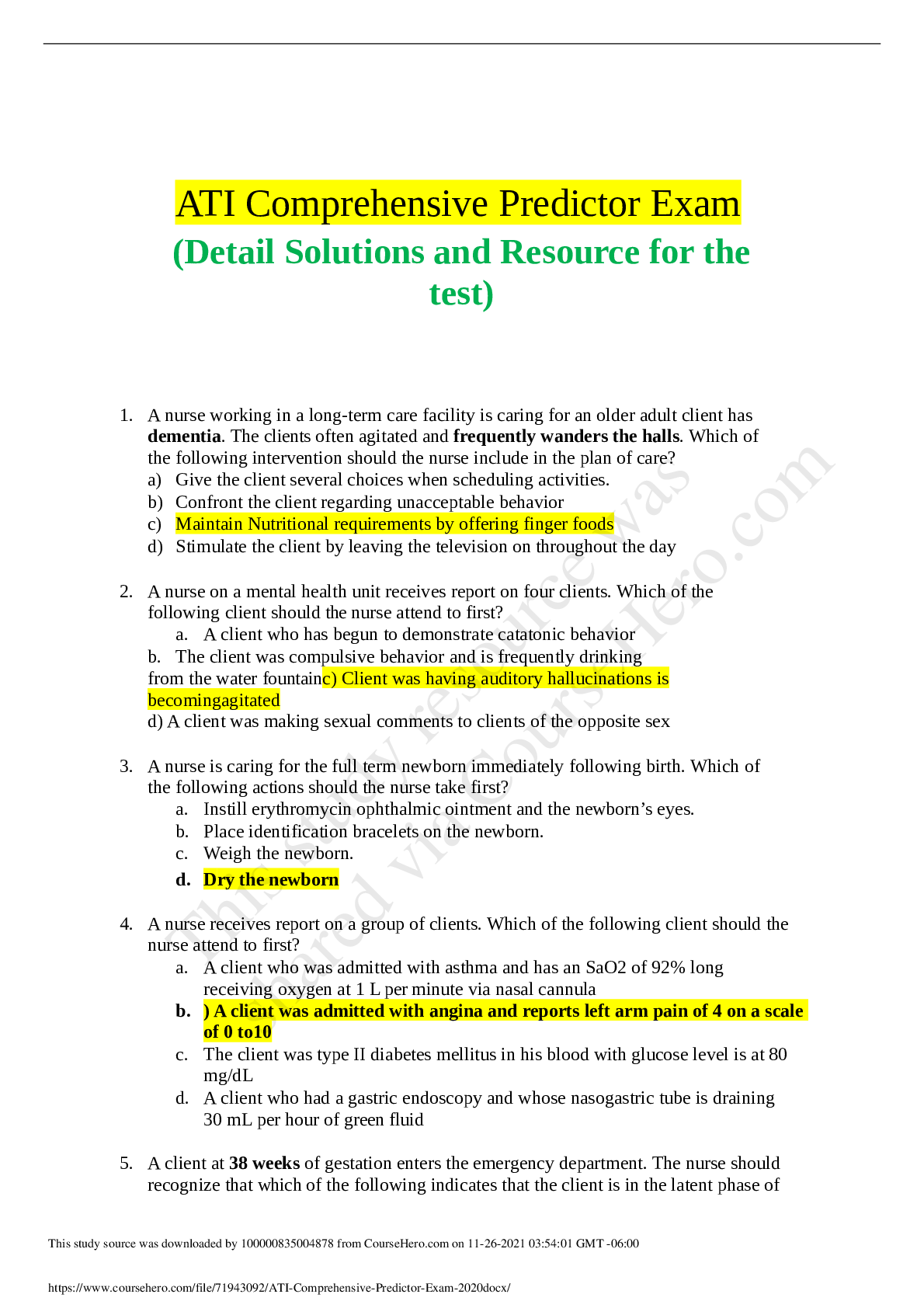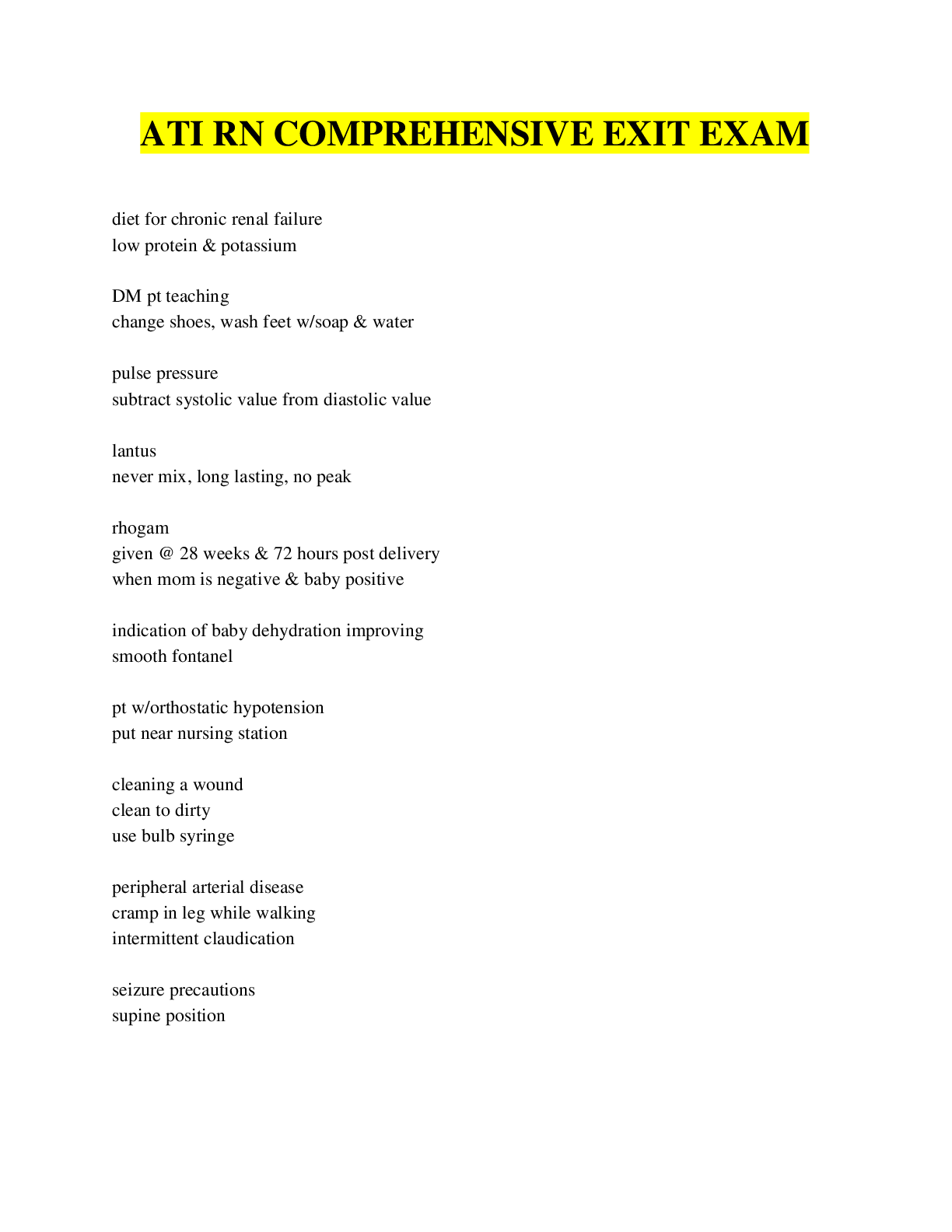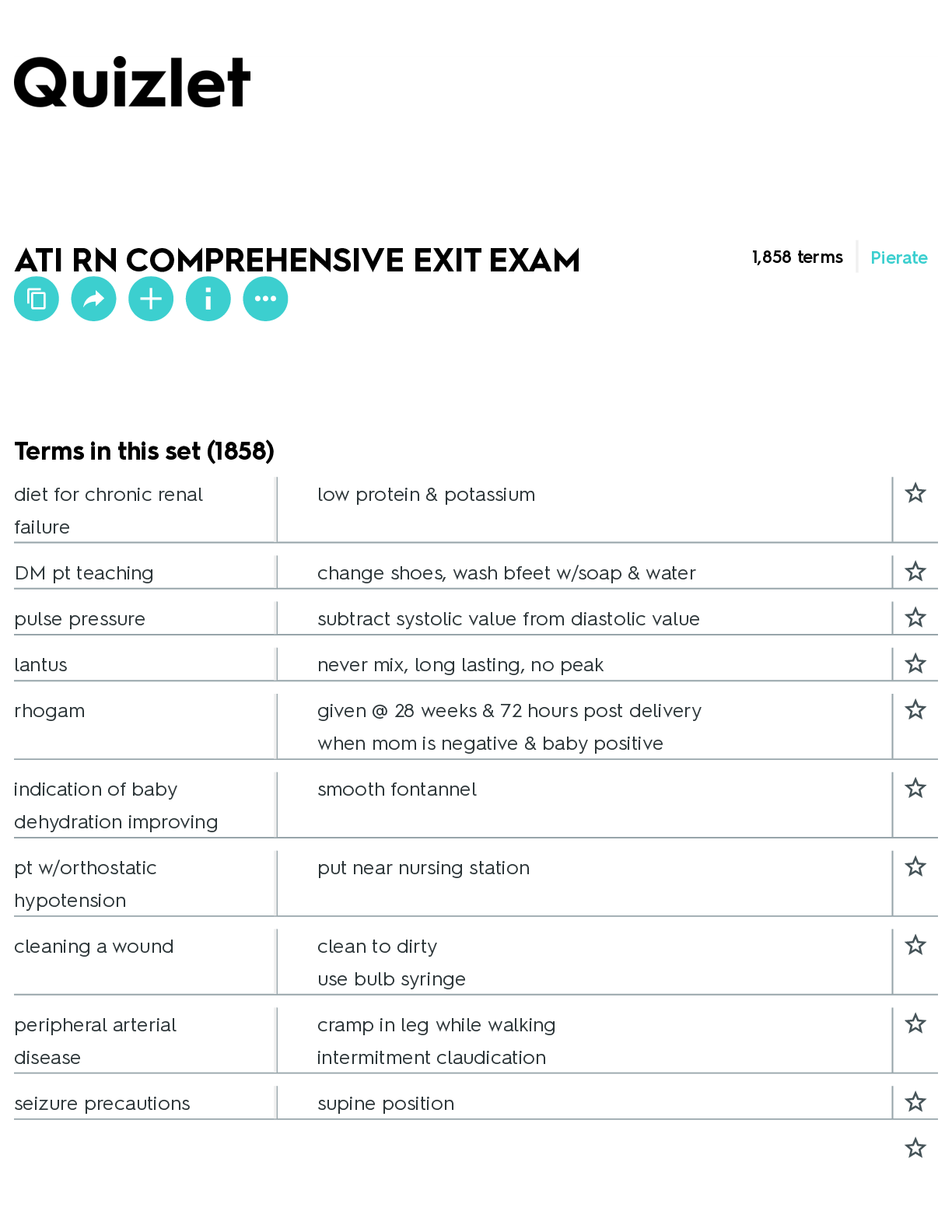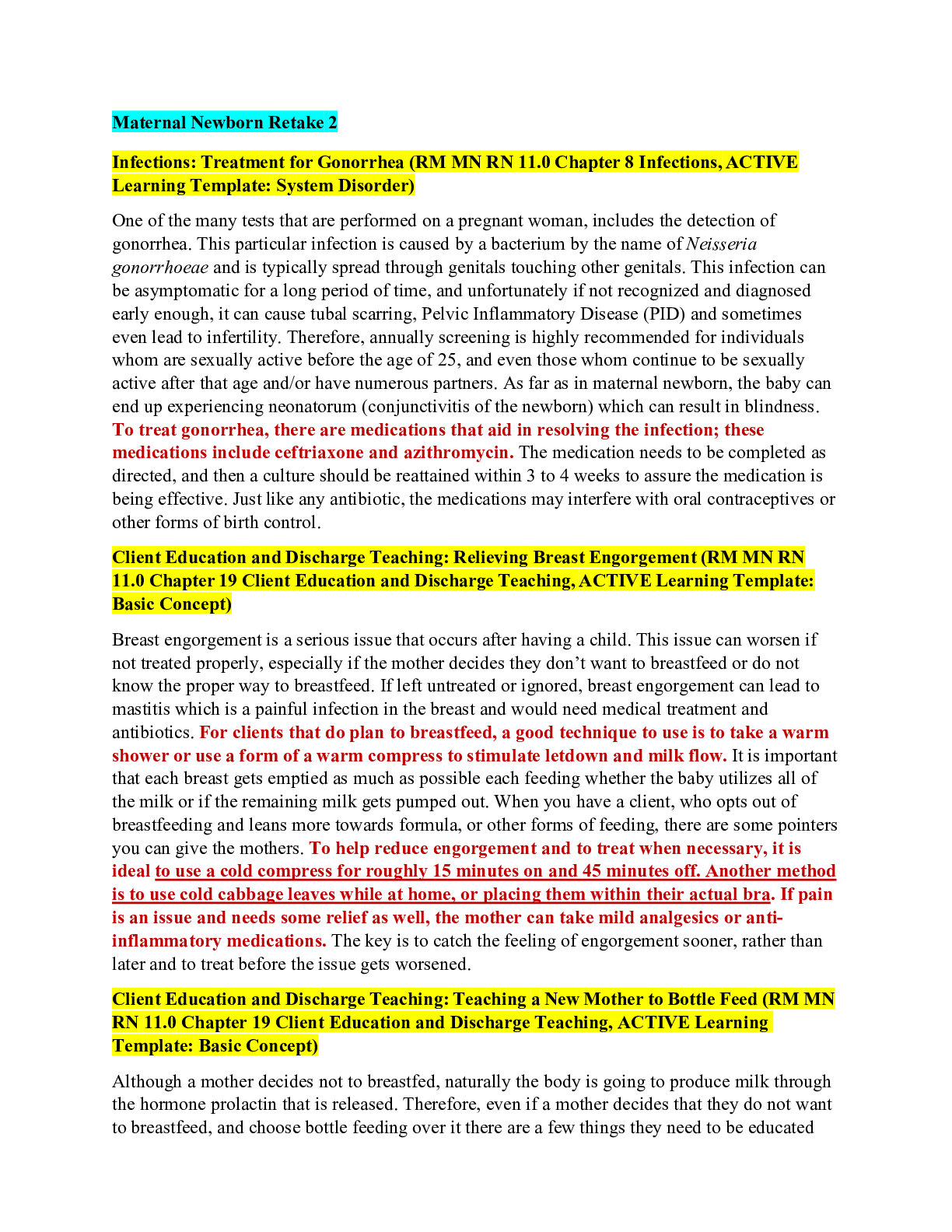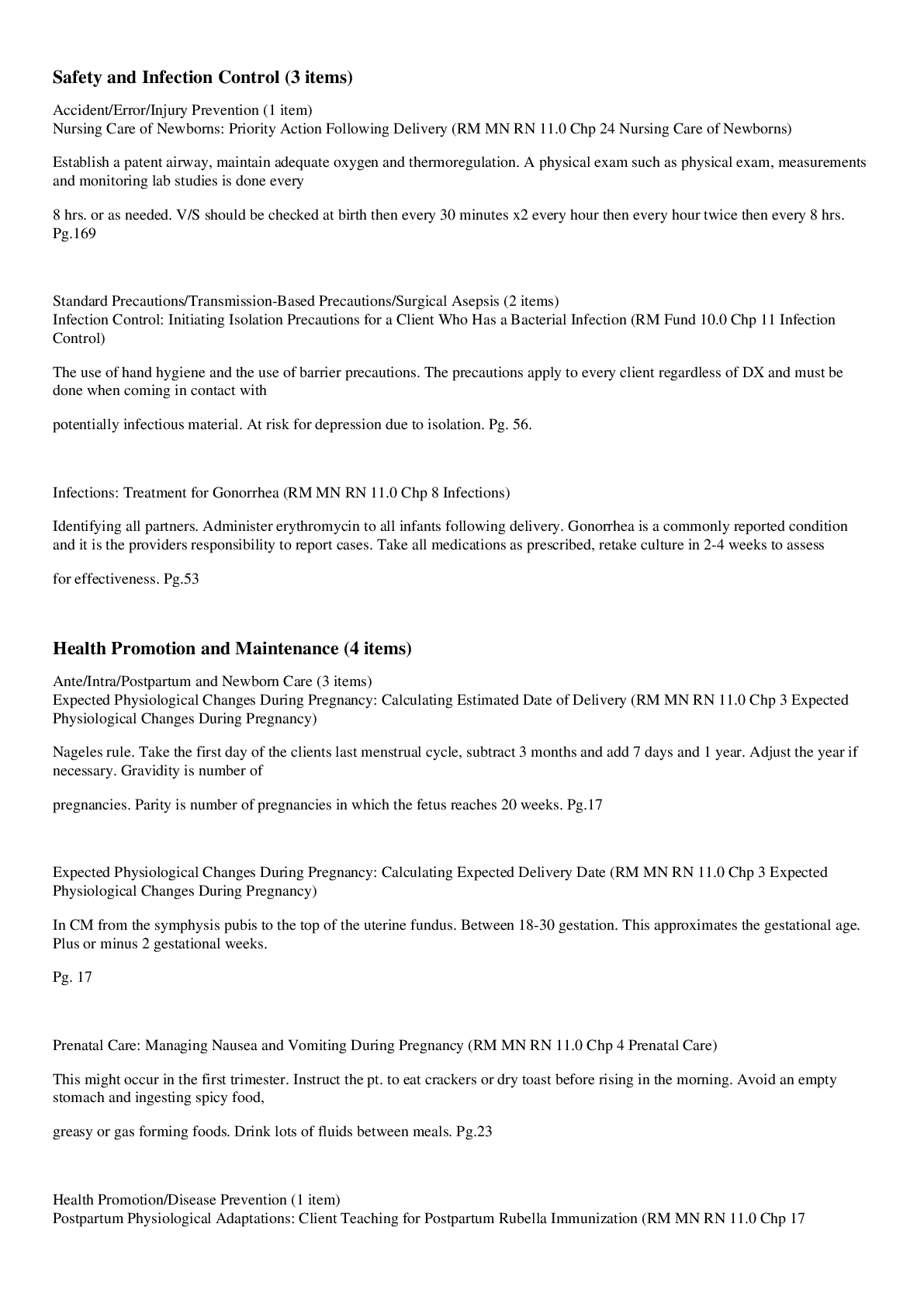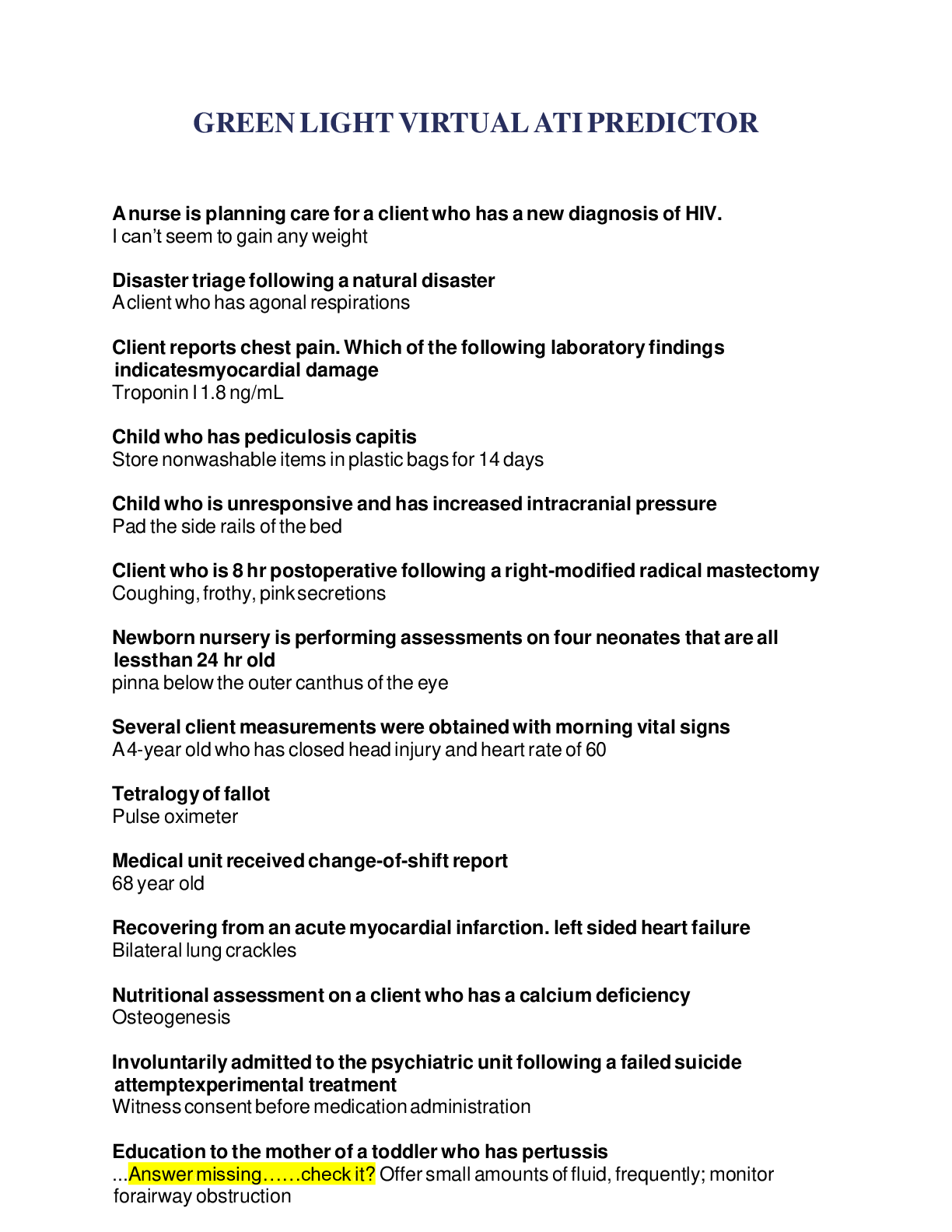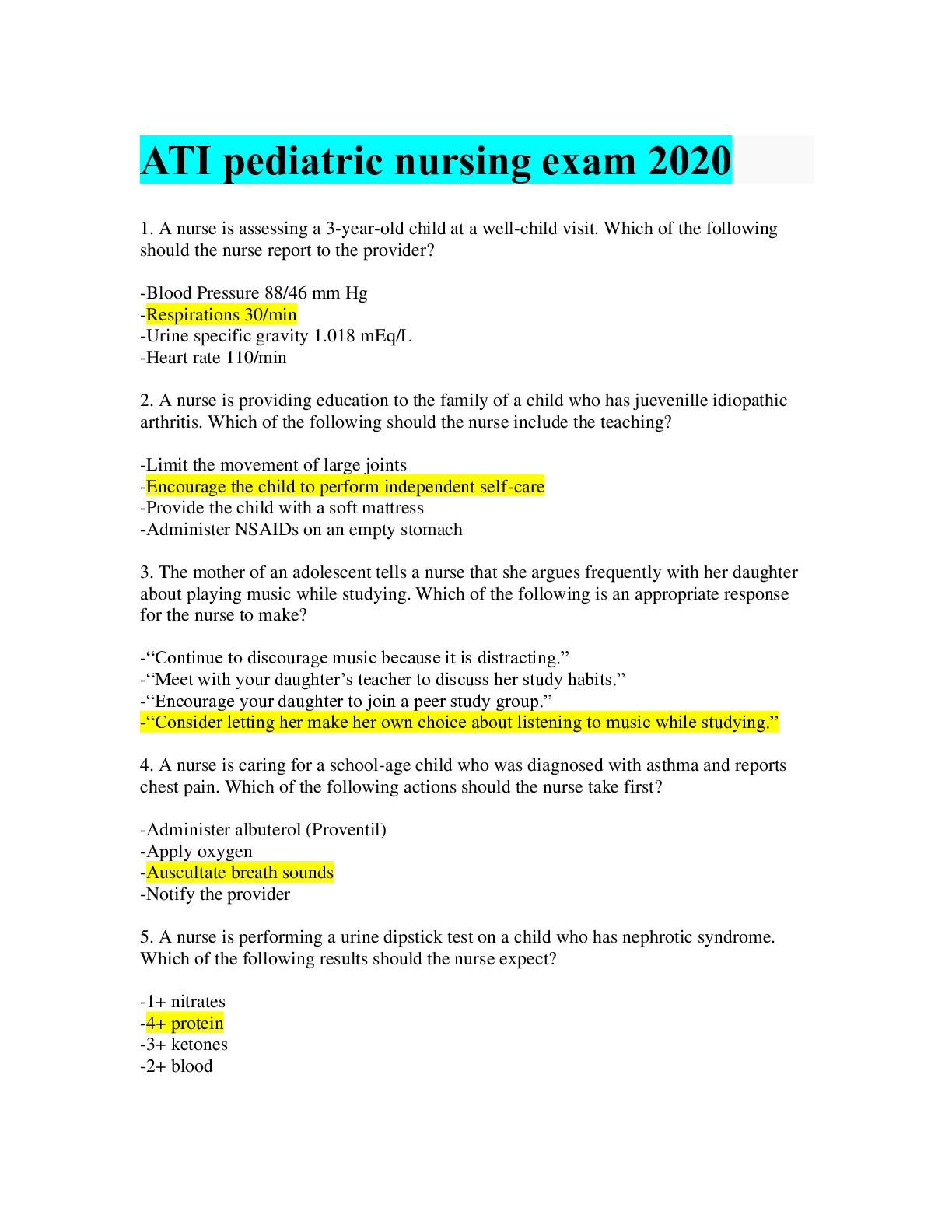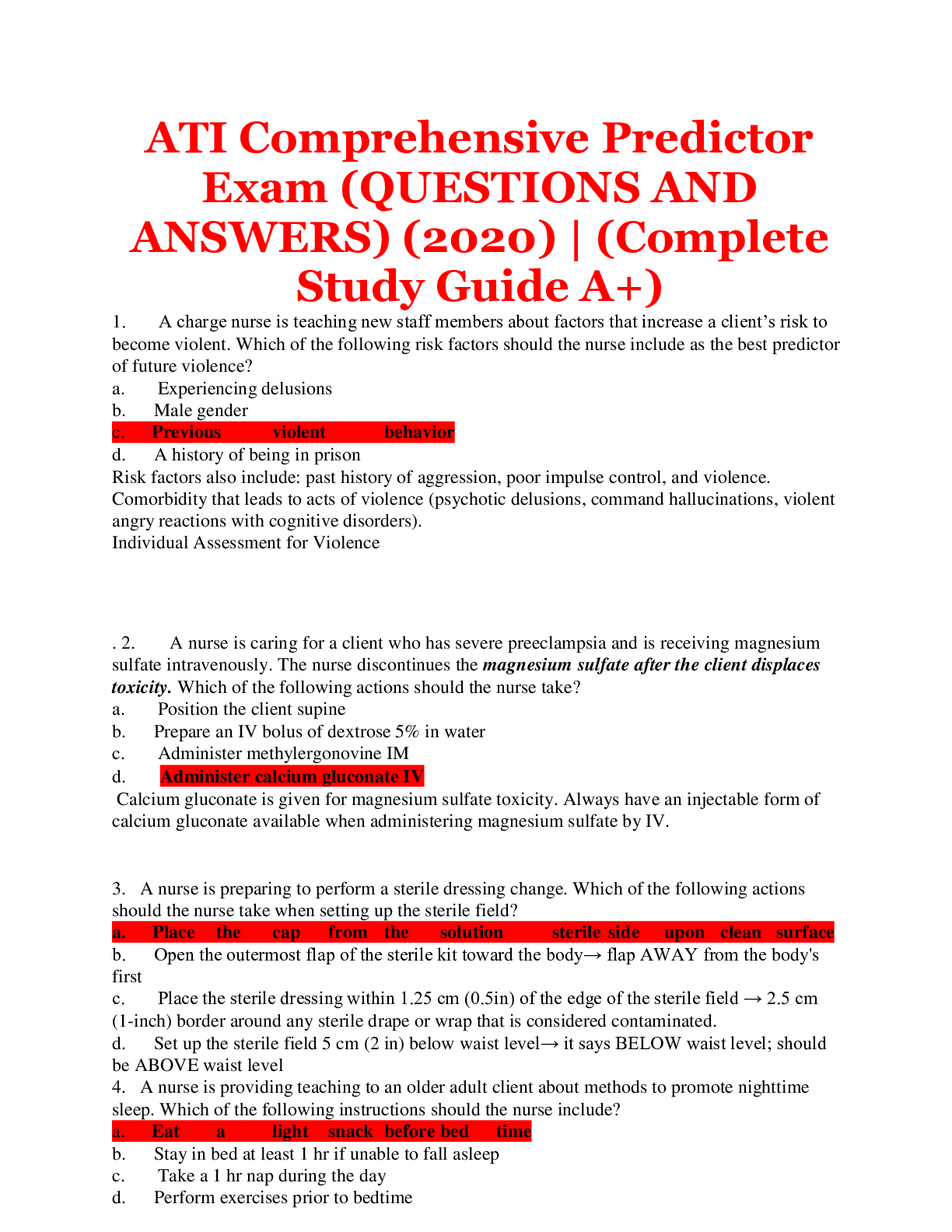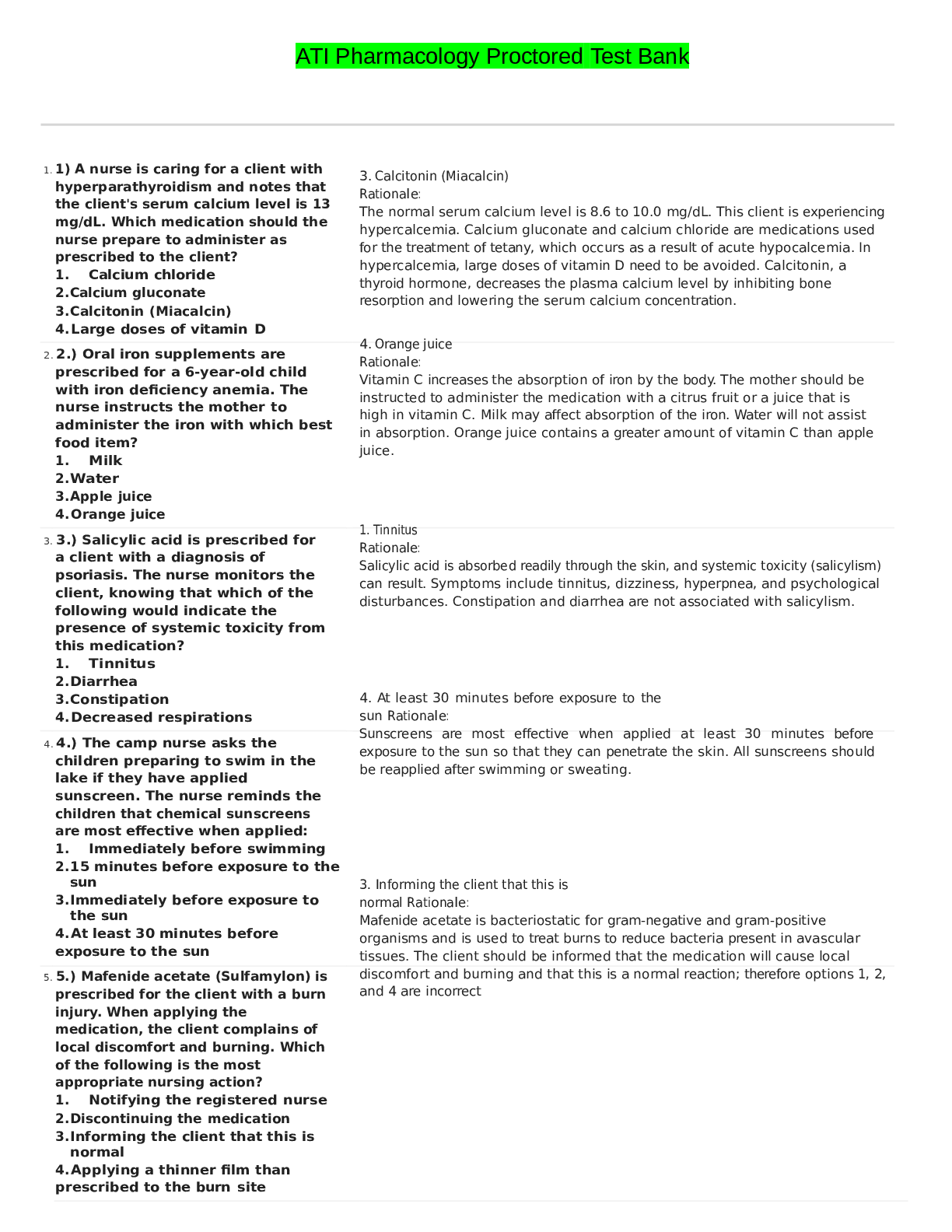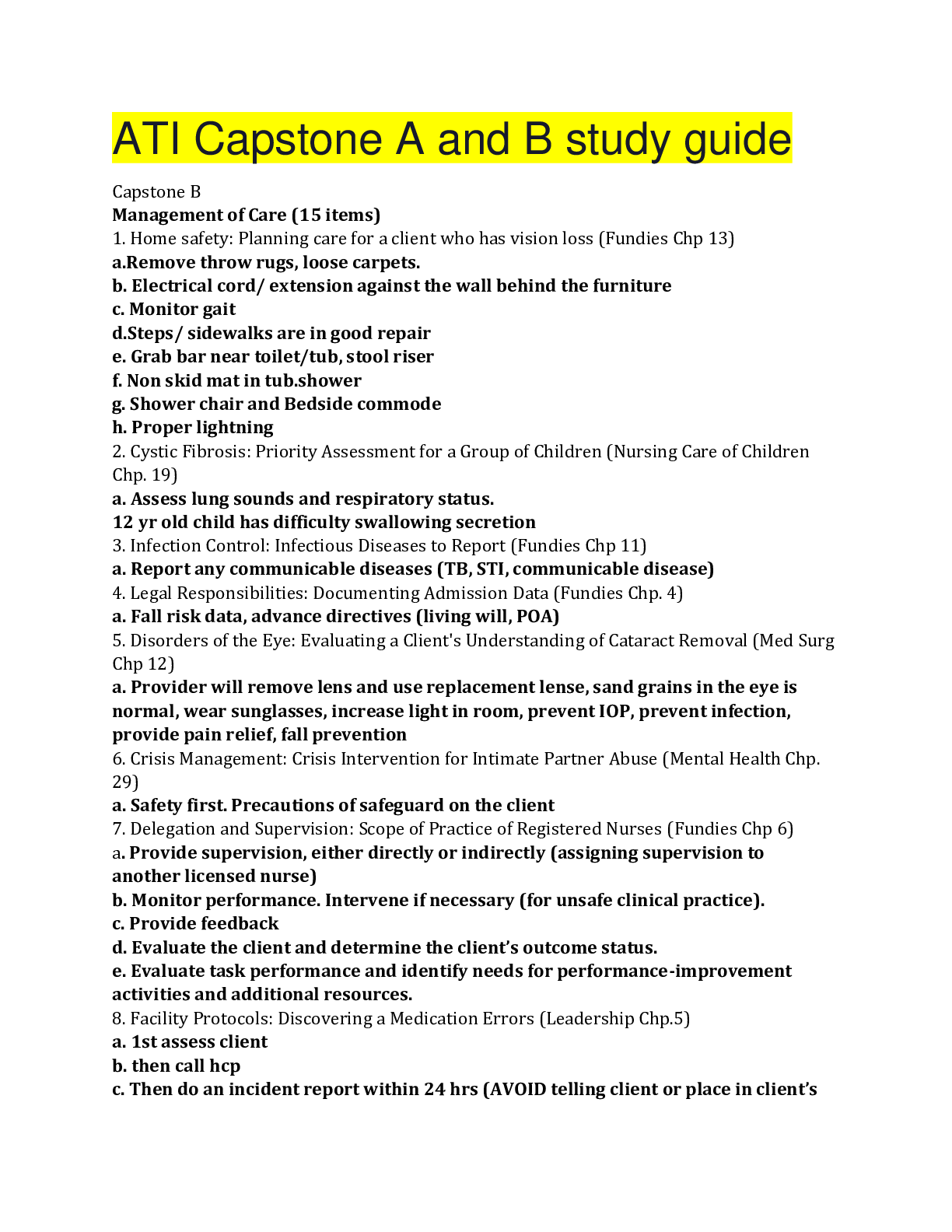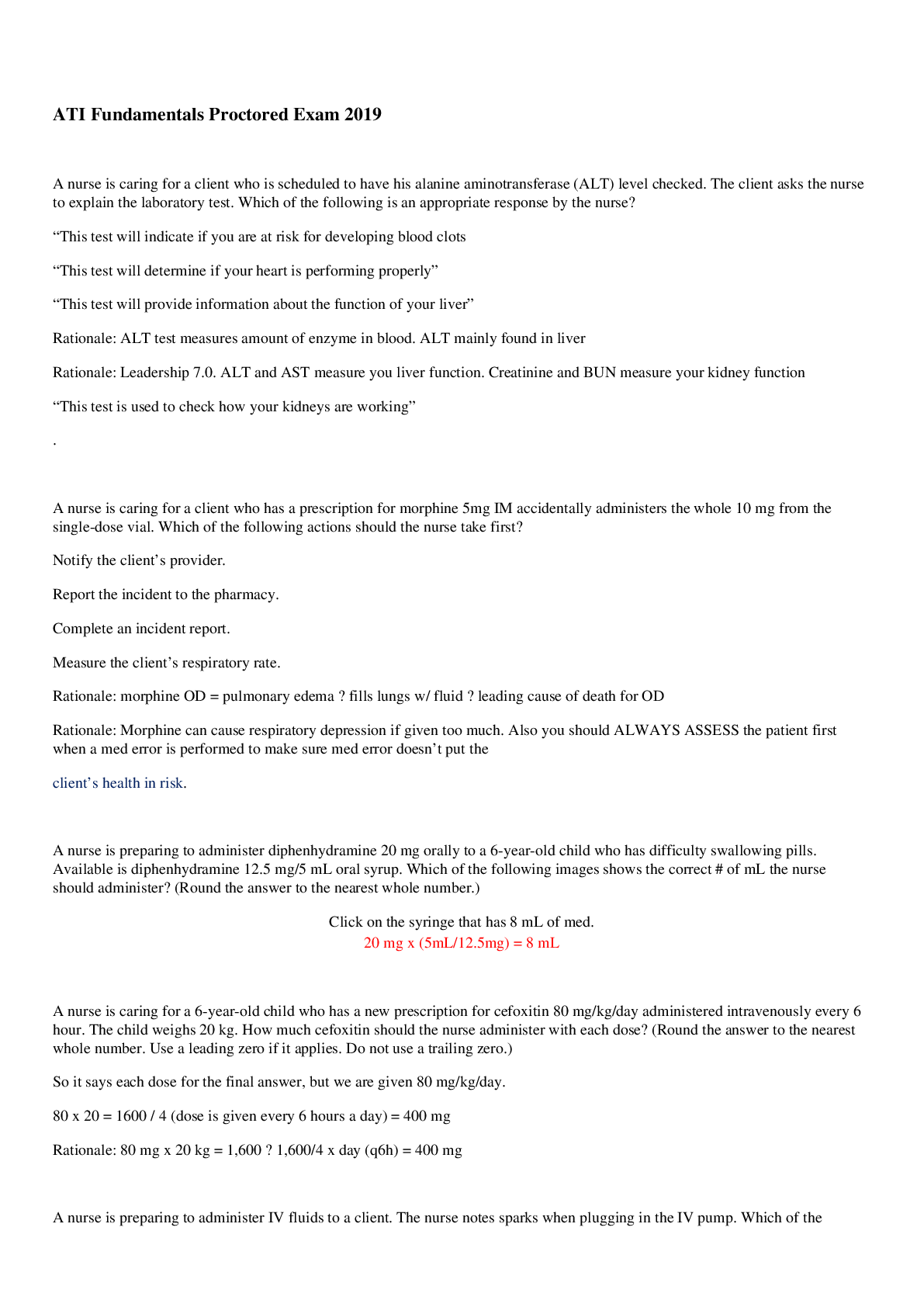*NURSING > QUESTIONS and ANSWERS > ATI Gerontology Final Quiz 2020 (All)
ATI Gerontology Final Quiz 2020
Document Content and Description Below
ATI Gerontology Final Quiz (Detail Solutions and Resource for the test) A nurse is completing medication reconciliation for an older adult client who is receiving multiple medications. Which of the fo... llowing actions should the nurse take first? A- Clarify the client list of medications with the pharmacist B- compare the current list against the new medication prescriptions C- investigate any discrepancies on that list D- ask the client about over the counter medications she is taking Answer- D The nurse should apply the nursing process priority-setting framework. The nurse can use the nursing process to plan client care and prioritize nursing actions. Each step of the nursing process builds on the previous step, beginning with assessment or data collection. Before the nurse can formulate a plan of action, implement a nursing intervention, or notify the provider of a change in the client’s status, she must first collect adequate data from the client. Assessing or collecting additional data will provide the nurse with knowledge to make an appropriate decision. When performing medication reconciliation, it is important that the nurse collect a list of all the medications the client takes in order to compare the full list of medications against any new medications the client will take. The list should include prescriptions, over-the-counter medications, and herbal and nutritional supplements. A- The nurse should clarify the client’s list of medications with the pharmacist, caregivers, providers, and the client; however, this is not the first action the nurse should take. B- The nurse should compare the medication list against any new prescriptions to ensure there is not any duplication of medications or potential medication interactions; however, this is not the first action the nurse should take. C- The nurse should investigate discrepancies on the list with the provider to prevent medication errors; however, this is not the first action the nurse should take. Exam 1? A nurse at a long-term care facility is planning care for a client who has Alzheimer's disease and wanders at night. Which of the following interventions should the nurse include in the plan? A- Place the client in wrist restraints at night B- request a prescription for a psychotropic medication C- assign the client to a room closer to the nurses station D- cheap the television on at night Answer- C The nurse should place the client who wanders in a room that allows for close observation. The nurse should provide clients who wander a safe place to walk and supervision when the client is ambulating. A- The nurse should protect the client from harm, but restraints can result in agitation. B- The nurse can administer a psychotropic medication to treat depression or emotional manifestations of Alzheimer’s disease, but not to treat wandering behaviors. D- The nurse should avoid the use of excessive light and sound stimulation for the client who has Alzheimer’s disease. This can cause further agitation and confusion for the client. The nurse at a long-term care facility is teaching an older adult client about ambulating with a quad cane. Which of the following statements should the nurse include in the teaching? A- Adjust the height of the cane so that you can flex your elbow at 45 degrees B- hold the cane in the hand on the stronger side of your body C- place the flat side of the cane away from your foot D- the cane and your stronger leg at the same time Answer- b The client should hold the cane with the hand on the stronger side of her body so that she can move the cane to support the weaker leg. This action allows for a more normal gait, with the ipsilateral arm and weaker leg moving at the same time. A- The nurse should instruct the client that the cane’s height should allow the elbow to be slightly flexed. Having a flexion of 45º would make the cane too tall for safe use. C- The client should place the flat edge of the base of the cane facing toward her foot. This allows the client to ambulate without the risk of getting her foot caught in the base of the cane and falling. D- The nurse should instruct the client to move the cane and her weaker leg at the same time. This action allows for a more normal gait with the ipsilateral arm and weaker leg moving at the same time. A nurse is performing a skin assessment for a group of older adult clients. Which of the following findings should the nurse identify as a benign, age related skin change commonly seen in older adult clients? A- Liver spots B- Nevi C- atopic dermatitis D- psoriasis Answer- a Liver spots, also known as age spots or lentigines, are flat, brownish-black macules that usually occur in sun-exposed areas of the body. Aging and exposure to sunlight, or other forms of ultraviolet light, can result in increased pigmentation. Liver spots are extremely common after 40 years of age; they occur most often on the forearms, shoulders, face, forehead, and backs of the hands, which are also the areas of highest sun exposure. They are harmless and painless, but they can affect the client’s cosmetic appearance. B- Nevi are moles, a growth of pigment-forming cells that might be benign or malignant. The nurse should identify that nevi occur throughout the lifespan. Further evaluation of the nevi should include evaluation of any asymmetry, border irregularity, color variation, diameter, and evolution, which can indicate melanoma. C- Atopic dermatitis, or eczema, is a chronic skin disorder that occurs in all ages, but is more common in infancy and childhood. Clients who have atopic dermatitis can have scaly and itching rashes. D- Psoriasis is a common skin inflammation with frequent episodes of redness, itching, and thick, dry, silvery scales on the skin. The nurse should identify that while generally a benign condition, psoriasis is a chronic, recurring condition in clients of all ages, most commonly in clients from 15 to 35 years of age. A nurse in an assisted living facility is assessing an older adult client who moved in three months ago following a death of his partner. The client reports Awakening early in the morning and admit to feeling very sad. The nurse should identify that the client is experiencing which of the following types of Grief? A- Anticipatory grief B- delayed grief C- acute grief D- disenfranchised grief Answer- c The client experiencing acute grief will have both somatic and psychological manifestations of distress, such as the inability to sleep well or profound sadness. The nurse should identify that this client is experiencing acute grief and further assess his support system, concurrent stressors in his life, and his ability to manage stress. A- The nurse should identify anticipatory grief as an expected response occurring prior to an actual loss. Clients experiencing anticipatory grief might be preoccupied with the impending loss, make extensive funeral arrangements, or exhibit a change in attitude toward the lost thing or individual. B- The client experiencing delayed grief is unable to accept the reality of a loss. The client remains in the denial stage of grief and is unable to allow himself to experience feelings of sorrow and loss. C- The client experiencing acute grief will have both somatic and psychological manifestations of distress, such as the inability to sleep well or profound sadness. The nurse should identify that this client is experiencing acute grief and further assess his support system, concurrent stressors in his life, and his ability to manage stress. D- The client experiencing disenfranchised grief cannot openly acknowledge the loss because of societal or religious norms. Useful Link: ATI Community Health Proctored Exam (23 Versions), New 2020,Question Answers,Verified correct Answers ATI RN COMPREHENSIVE EXIT EXAM COMPLETE (14 versions), New 2020,Question Answers,Verified correct Answers ATI Comprehensive Predictor Exam, (14 versions), New 2020,Question Answers,Verified correct Answers ATI RN COMPREHENSIVE EXIT Final EXAM COMPLETE, (14 versions), New 2020,Question Answers,Verified correct Answers ATI PN Comprehensive Exit Exam, (14 versions), New 2020,Question Answers,Verified correct Answers RN Comprehensive Predictor 2019 Form A,B Each 180 QA, (Latest versions), New 2020,Question Answers,Verified correct Answers ATI Leadership Exam (13 Latest Versions), ATI Leadership Exam, Question Answers,Verified correct Answers ATI Fundamentals Exam (7 Versions-), ATI Fundamentals Exam, Question Answers,Verified correct Answers ATI Leadership Proctored Exam (13 Versions), ATI Leadership Proctored Exam, Question Answers,Verified correct Answers ATI MED SURG RESPIRATORY (5 Versions), ATI MED SURG RESPIRATORY, Question Answers,Verified correct Answers ATI Maternal Newborn Proctored Exam (11- Versions), ATI Maternal Newborn Proctored Exam , Question Answers,Verified correct Answers ATI Nutrition (4 Versions), ATI Nutrition, Question Answers,Verified correct Answers PN Management Online Practice 2017 A / PN Management Online Practice 2017 B, Question Answers,Verified correct Answers ATI pediatric Proctored Exam (6 Versions), ATI pediatric Proctored Exam, Question Answers,Verified correct Answers ATI Med-Surg Proctored Exam (14 Versions)/ ATI Med-Surg Proctored Exam, Question Answers,Verified correct Answers VATI ATI leadership Management/ATI Leadership Management Proctored Exam-( 2 versions), Question Answers,Verified correct Answers ATI Mental Health Proctored Exam (16- Versions)/ ATI Mental Health Proctored Exam, Question Answers,Verified correct Answers ATI Proctored Pharmacology Exam ( 15 Versions)/ ATI Proctored Pharmacology Exam, Question Answers,Verified correct Answers ATI NR 293 Pharmacology Midterm and Final Review, Question Answers,Verified correct Answers ATI Maternity Practice Exam Exam,(11 Latest Versions) ATI Community Health Proctored Exam (20 Versions), New 2020,Question Answers, ATI Community Health Proctored Exam, Verified correct Answers ATI Gerontology Final Quiz (3 Versions),New 2020,Question Answers, Verified correct Answers N212 GERO ATI LEARNING SYSTEM RN 2.0 GERONTOLOGY FINAL QUIZ (3 versions), New 2020,Question Answers,Verified correct Answers [Show More]
Last updated: 1 year ago
Preview 1 out of 21 pages
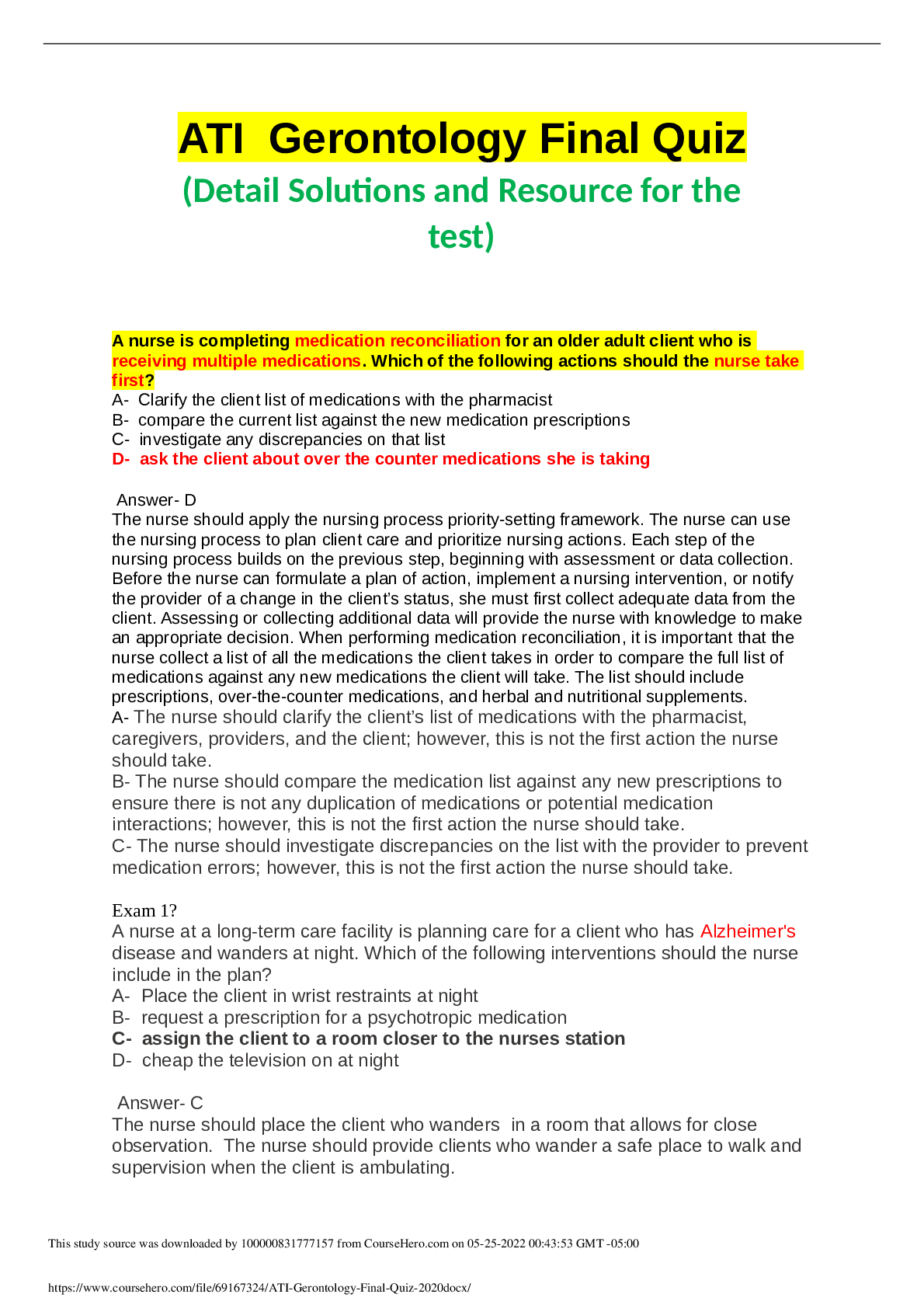
Reviews( 0 )
Document information
Connected school, study & course
About the document
Uploaded On
Dec 16, 2020
Number of pages
21
Written in
Additional information
This document has been written for:
Uploaded
Dec 16, 2020
Downloads
0
Views
94

